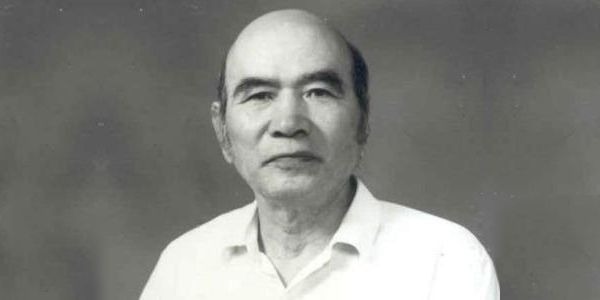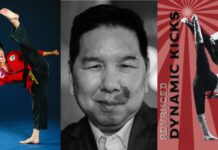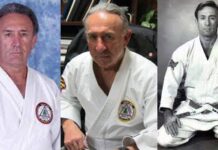
Kenshiro Abbe was born on the 15th December 1915, in a small village on the island Shikoku, part of the Tokushima Province. It was less than a lifetime since the end of the Samurai era. He was the fourth son of Toshizo and Kote Abbe. His father, Toshizo, was the local school headmaster and a Kendo Sensei.
Unfortunately though, Kenshiro was never to get to train with his father, the latter being swept to his death in a flash flood whilst training in the mountains on a weekend Kendo course. Kenshiro was only four years old at the time. However, the young Kenshiro had inherited his father’s enthusiasm for physical sports and pastimes, particularly the martial arts. He was soon involved in the junior Sumo and wrestling competitions at his school. Kenshiro was very strong for his age and won many of these competitions, and eventually went on to become the schools area champion.
Then in 1929, at age 14, Kenshiro took up Judo, newly introduced to the area. The instructor was Kazohira Nakamoto Sensei, a former police officer. Kenshiro, without doubt, had found home, his appetite being insatiable. Pretty soon he was awarded his 1st Dan. His talent must have been truly outstanding, as within another year he was awarded NiDan, or 2nd Dan. At the age of only 16 he became the Tokushima Province champion in the High School League, and was then graded 3rd Dan. He was the youngest person ever to be awarded this grade in Judo. Later, during his 5th year at high School, Kenshiro represented the town of Kawashima as team captain in an inter-town competition involving over 30 towns.
Kenshiro, although very well built for his age, was extremely light and fast on his feet, he threw every one of his opponents in his contests. Kenshiro was now attracting a lot of attention, particularly from one of the referees, a Shotaro Tabata, who was an official referee from the Butokukwai based in Kyoto. Tabata approached Kenshiro and advised him to apply to the Busen College. This was an extremely exclusive martial college of the Butokukwai. Kenshiro applied, and from some 300 applicants that year he was one of only 20 to be accepted.
Kenshiro moved to Kyoto with his mother and sister and studied Kendo and Judo. His Kendo studies were with Ogawa Hanshi 10th Dan sword master. Kenshiro was also awarded his 4th Dan Judo that year, the first ever by the Butokukwai.
(The Dai Nippon Butokukwai had recently been re-established in 1895. It was closed by General Macarthur at the end of WW11 and remains closed to this day.)
Traditionally every Saturday afternoon, Judo contests would take place at the Busen. Kenshiro would have to fight 5 opponents in succession, each contest lasting 5 minutes. Kenshiro never lost a fight and the following Autumn, only his second year at the Busen, he was awarded his 5th Dan. He was the youngest Judoka ever to receive this rank. and remains so today.
On May 31st 1938 Kenshiro Abbe met Masahiko Kimura of the Kodokan for a contest arranged by the Imperial Police Guard. These two men were regarded as the two greatest Judoka of their time. Three other top ranking Judoka also took part. Kenshiro Abbe beat all the contestants including the great Kimura. This was one of only four contests that Kimura lost in his whole career. He was heard to comment after being beaten by Abbe Sensei “It was like fighting a shadow”.
In 1938 Kenshiro received his 6th Dan Judo. In 1945 he was awarded the rank of 7th Dan Judo and 6th Dan Kendo by the Butokukwai, and in 1949 became the chief instructor to the Kyoto police and the Doshisha University.
In the June of 1937, aged only 21, Kenshiro Abbe enlisted in the army, and for the next four years served in Manchuria. Unable to continue in Judo during that time, he did continue with his Kendo training, as he was an officer.
His military career ended in 1941 and he returned to the Busen. However, Japan entered the Second World War and he was recalled to Tokushims as the head of a training unit. The Japanese were now concentrating on a new art, Jukendo, the art of bayonet fighting, Kenshiro Abbe entered these studies as assiduously as his other arts and soon became a leading exponent. It was during this time that Kenshiro Abbe was to meet someone who would alter his path. While traveling on a train Abbe noticed an older man staring at him who then asked if he was a 5th Dan Judo. Abbe replied “Why yes, how did you know that?” “because you have the build of a 5th Dan. So who are you? “Kenshiro replied, “ Everyone knows who I am, I am Kenshiro Abbe, Judo champion of all Japan! “Yes, I can see that, “the old man replied. The old man continued to talk to Kenshiro much to his annoyance as he wanted to get some sleep. Eventually, the old man put a finger in Kenshiro’s face, ` you are so powerful, break my finger!”
Kenshiro was only too happy to oblige. He took the finger, expecting to snap it like a twig, and wham! He found himself on the carriage floor under the full control of the old man. The old man allowed Kenshiro to get back into his seat. “ Who are you?” Kenshiro Abbe asked.
“I am Morihei Ueshiba, the founder of Aikido.” Kenshiro Abbe was astounded at the technique of the old man and requested that he become his student, Ueshiba agreed, and Kenshiro Abbe studied with Ueshiba for 10 years.
Morihei Ueshiba had a profound and lasting impression on Kenshiro, and not just on a physical level. His spirituality also influenced Kenshiro, particularly as the young man was beginning to question all that was around him, especially a world that was obsessed with materialism and selfishness.
Following the war, many of the arts in Japan were going through radical changes, many to meet new demands based on competitive results, the need and desire to win being more important than the art. Kenshiro Abbe was disillusioned with this, particularly with Judo, seeing it decline. In the 1950’s Kenshiro Abbe severed his ties with the Kodokan.
Now aged 40, Kenshiro Abbe headed to Britain at the invite of the London Judo Society. This was 1955. Kenshiro Abbe though was not happy. He felt the students of the LJS were more interested in competition than the new theories he was bringing. This new theory was Kyu-Shin-Do, a spiritual philosophical way bound in Budo. He first started formulating this theory while serving in the army, although until now he had kept it to himself.
He believed that Kyu-Shin-Do offered an alternative to the way the world was going. He also believed it was a philosophy that one experienced rather than sat down and studied. It is probably for this reason, and his extremely poor English, that he had difficulty getting his theory across. Kyu itself meant desire, search or study.Shin meant heart, spirit, true inner nature, and Do means way or path. But it was much more than words.
There are those who claim to teach Kyu-Shin-Do, and some even claim to have had long philosophical discussions with Kenshiro Abbe over this theory. There are bizarre claims by George Mayo to have himself been the founder and developer of Kyu-Shin-Do. These people are deluding themselves, and at worst, telling lies. Kenshiro Abbe’s grasp of the English language was so poor that it would make any form of deep debate impossible.
Further, he felt the students of the LJS did not treat him with the respect he deserved at such a high grade. It is stated during one lesson, Kenshiro Abbe lined up thirty one Dan grades, he told each one of them which technique he would use on them and whether it would be right or left handed technique, he proceeded to do exactly that and beat every one of them.
In 1955 Abbe Sensie introduced Aikido to Britain first at a demonstration at the LJS and then at the Royal Albert Hall in London also in 1955. He also taught and demonstrated Ju-Kendo, Kendo, Karate, Yari and Naginata. Ken Williams Sensei a respected Judoka, he became the first student of Aikido in Britain.
Politically, things started to move quite swiftly. In 1958 the British Judo Council was formed under Kenshiro Abbe Sensei and Mutsutharu Otani Sensei who’s son Robin Otani Sensei is the President of the BJC today. followed quickly by the British Aikido Council and the British Kendo Council.
Abbe was now traveling quite extensively throughout the UK and Europe and inviting many European based Japanese Masters to teach in Britain.
However, in 1960 Abbe was involved in a car accident that left him with severe whiplash injury that would forever plague him, and affect his teaching in later years.
In 1964 Kenshiro Abbe returned to Japan for the Olympics. While there, he visited Ueshiba, informing him of the development of Aikido in Britain, and requesting another instructor to go to Britain from the Hombu. Ueshiba sent a young instructor TK Chiba Sensie in 1966.
In 1967, Abbe Sensei returned to England. What he returned to broke his heart. Many changes had taken place in his absence, and not all to his liking or belief in Kyu-Shin-Do. Abbe Sensei asked several of his former colleagues to help him rebuild the old BJC, but for the first time, his colleagues and students, refused.
Kenshiro Abbe was broken spiritually, in poor health, totally disillusioned and now without a purpose. He returned to Japan and lived with his family until his death on the 1st December 1985. The world had lost one of its greatest Budo masters.
There are many many stories about Kenshiro Abbe and his life in Britain. Some are funny, some are sad, some are quite profound.
Without a doubt, if it wasn’t for Kenshiro Abbe, the face of martial arts in the UK, today would be a completely different one, and that is no exaggeration.
~ This article by Martial Arts Illustrated correspondent Keith Morgan and Henry Ellis was originally published in the December 2006 issue of Martial Arts Illustrated. MAI and Keith Morgan have kindly consented to allow this article to be re-published on USAdojo.com to make the martial arts community more aware of the life of this great Budo master.
Martial Arts Illustrated – December 2006
Bends the Branch Series by Keith Morgan – Shin-Gi-Tai JuJutsu
Following my article, The Long and Winding Road, featuring Henry Ellis and Derek Eastman, I received many calls and emails asking me about Kenshiro Abbe. The great advantage of writing this column is that I get exposed to many great people, and hence new friends, and so it was to Henry Ellis that I turned to get information. This particular piece could not have been written without his help and selfless assistance. I would also like to thank Henry for the unlimited access to his private and personal photograph collection.





